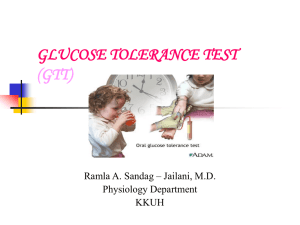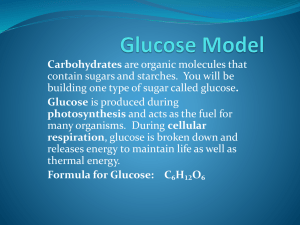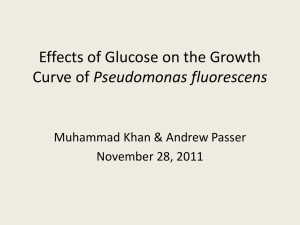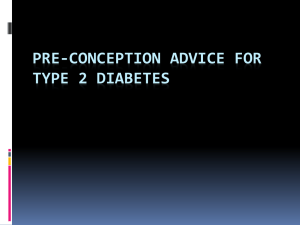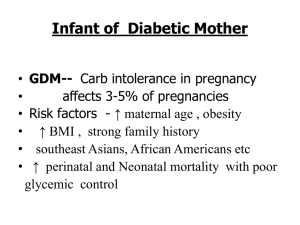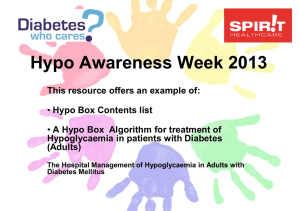presentation 2 - Faculty Server Contact
advertisement
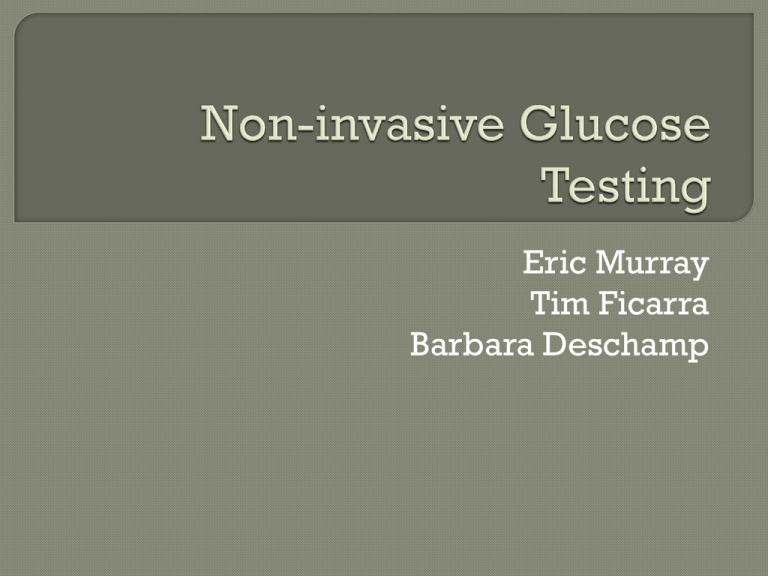
Eric Murray Tim Ficarra Barbara Deschamp Eric • Spectroscopy Tim • Reverse Iontophoresis Barbara • Fluorescence Study of the interaction of matter and light Light is focused on some area of the body Light is absorbed and reflected in different ways by different substances. Subcategories include near-infrared, mid-infrared, and photoacoustic spectroscopy. Goal is to understand glucose's spectroscopic properties, in order to identify its presence in a sample Functions in .7 – 2.5 micrometer range Explores tissue depths of 1 to 100 millimeters Diffuse Reflection: Using NIR light to illuminate a spot on the body Light is partially absorbed, scattered, and reflected back to a detector Reflectance spectrum of skin is compared to reflectance spectrum of the glucose. A graph of the absorbance spectrum of skin contains different spectral signatures for different components that are present. Glucose bands located at 1613, 1689, 1732, 2105, 2273, and 2326 nm. Work by Malin et al. Used custom-built scanning near-infrared spectrometers. Detectors were composed of indium-galliumarsenide Human forearm was the target Instrument observed the intensity spectra for diffuse reflectance for the wavelength range 1050-2450 nm Sampling interval was 1 ns. Data from Malin's experiments Prediction error of 9.1% Prediction error of 3.6% Image Source: Malin, Stephen F, et al. “Noninvasive Prediction of Glucose by Near Infrared Diffuse Reflectance Spectroscopy.” Clinical Chemistry, Vol. 45, No. 9. 1999 Sensys GTS by Sensys Medical, Inc. Been in development for 16 years Design changes have been a result of the dynamic nature of skin Texture Color Temperature Further design changes to address positioning of the skin. Glucose is very effective at absorbing mid-infrared light Unfortunately, so is water The body's emission spectrum can be used to measure glucose. If the glucose to be measured is at the same temperature as the tissue it's present in, no glucose spectrum will be observed in the emission spectrum. Mid-Infrared Spectroscopy Developed by OptiScan Biomedical Corporation. Uses mid-infrared spectroscopy Unfortunately, their current implementation is invasive, drawing blood every 15 minutes. Used for patients in critical condition. Image source: http://optiscancorp.com/optiscanner.html A beam of light is used to heat a target. Optical energy from the light is converted into acoustic energy. This acoustic wave can be measured with a microphone. The optimum wavelength for glucose detection is 9.676 micrometers. One study (MacKenzie et al.) used nearinfrared pulse laser sources, and piezoelectric transducers. The following relationship was found: y = 0.21x – 0.02 where y is the change in the photoacoustic response and x is the glucose concentration Correlation coefficient was 0.99 Very accurate and promising Equipment is expensive Testing equipment is extremely sensitive and requires a controlled environment. Technique for extracting subdermal molecules • Apply DC current to the skin • Current attracts charged molecules • Force of the flow also draws neutral molecules Glucose and lactate are among the molecules which can be extracted First commercially available non-invasive glucose measurement technique • Continuous monitoring • Requires blood test for calibration • Suffers inaccuracy in detecting hypoglycemia Discontinued 2007 by Animas Corporation in There is a metabolic relationship between lactate and glucose levels • Lactate can be extracted using reverse iontophoresis • Lactate measurement could be used to improve accuracy of GlucoWatch or similar technologies Lactate measurement is still being investigated Tool for blood sugar testing • Two minute test • Utilizes five sensors In regions rich with sweat glands 2 hands, 2 feet, 1 forehead Requires no calibration Still in developmental stages Metabolic heat conformation Carbon nantoubes (reverse iontophoreris) Fluorescence Focus is on Fluorescence by means of a contact lens, most diabetics need corrective lenses due to vision problems caused by the disease Ultimately it was most continuous and non invasive form Emission of light by a substance that has absorbed light of a different wavelength • Wavelength A is absorbed • Wavelength B is then emitted Using a boronic acid doped contact lens, glucose levels are monitored through tears binding with the boronic acid The sensor responds to the different concentrations through the diffraction of light7 therefore changing fluorescence and wavelength Measurements are taken by a handheld device that correspond to blood glucose levels It is a electron deficient acid With the presence of glucose becomes electron rich The changes of the boron atom can be noticed by fluorescence spectral changes in the probe Doped lenses which react to tear glucose level and measured by handheld device Sensors on the lens that change color according to the glucose concentration in tears Elevated tear glucose levels were first demonstrated by Michail, as early as 1937 7 Does not suffer from fluctuations of ambient light Has a 30 min lag time with blood glucose levels Correlation coefficient of 0.998 9 • Response to various pH (in the range of 6.5-8.5) • Polarity response • Sensitivity enough to detect low concentrations of healthy person the high levels of a diabetic • Comfort (daily disposable contact lens)6 Biocompatibility Sensitivity Low pH and polarity Toxicity (one study uses off the shelf lenses)7 1. Current development in non-invasive glucose monitoring, Amaral et al., Science Direct, Medical Engineering & Physics 30(2008)541-549 2. A glucose-sensing contact lens: from bench top to patient, Lakowics, Current Opinion Biotechnology 2005;16,100-107 3. Fluorescent measurement in the non-invasive contact lens glucose sensor. Diabetes Technology Therapeutics 2006;8, 312-317 4. Fluorescence glucose detection: advances toward the ideal in vivo biosensor, Moschou et al Journal of Fluorescence, 14,5: September 2004 5. Current Problems and Potential Techniques in In Vivo Glucose Monitoring, Wickramasinghe et al, Journal of Fluorescence, Vol 14, : September 2004 6. Clinical trial of noninvasive contact lens glucose sensor, March et al Diabetes Technology Therapeutics. Volume 6; 782-789Dec 2004 7. A Glucose sensing contact lens: A new approach to non-invasive continuous physiological glucose monitoring, Badugu et al, Journal of Fluorescence vol. 13, No.5 September 2003 8. The Pursuit of Noninvasive Glucose: “Hunting the deceitful Turkey”, John L. Smith 9. Contact-lens Type Glucose Sensor Fabricated using Bionic-Mems Techniques for monitoring of Tear Sugar, Chu, Tokyo 10.. "Diabetes Statistics - American Diabetes Association." 26 Jan. 2011. Web. 28 Feb. 2011. <http://www.diabetes.org/diabetes-basics/diabetes-statistics/>. 9. Mathur, Ruchi. "Hemoglobin A1c Test Information on MedicineNet.com." MedicineNet. Ed. Shiel. 15 Jan. 2009. Web. 01 Mar. 2011. <http://www.medicinenet.com/hemoglobin_a1c_test/article.htm>. William C. 10 "Diabetes - What Should My Blood Sugar Levels Be? - Diabetes Mellitus, Type 2 Diabetes, Type 1, and Metabolic Disorders Treatment and Medications on MedicineNet.com." MedicineNet. Ed. William C. Shiel. 29 Mar. 2002. Web. 01 Mar. 2011. <http://www.medicinenet.com/script/main/art.asp?articlekey=17384>. 11. "Product Information." Medtronic Minimed, Inc. Web. 01 Mar. 2011. <http://www.minimed.com/products/index.html>. 12. Mendosa, David. "GlucoWatch." David Mendosa: A Writer About Diabetes. 31 Oct. 2007. Web. 01 Mar. 2011. <http://www.mendosa.com/glucowatch.htm>. 13. C.T.S. Ching, P. Conolly, Asian Journal of Health and Information Sciences, Vol. 1, No. 4, pp. 393-410, 2007. 14. A. Ramachandran, et al., A New Non-Invasive Technology to Screen for Dysglycaemia Including Diabetes, Diab. Res. Clin. Pract., 2010. 15. Tak S Ching, Patricia Connolly, Simultaneous Transdermal Extraction of Glucose and Lactate from Human Subjects by Reverse Iontophoresis, International Journal of Nanomedicine, 2008 16 Kiel. “Near Infrared Spectroscopy. Introduction into the method.” 2004. Web. 04 Apr. 2011. <http://www.ga-online.org/files/kiel2003/WS_Roos.pdf> 17. Malin, Stephen F., et al. “Noninvasive Prediction of Glucose by Near-Infrared Diffuse Reflectance Spectroscopy.” Clinical Chemistry, Vol. 45, No. 9. 1999. 18. "Sensys Medial, Inc – Near-Infreared Spectroscopy." Diabetes Mall. 2010. Web. 03 Apr. 2011. <http://www.diabetesnet.com/diabetes_technology/meters-monitors/future-metersmonitors/sensys-medical>. 19. Klonoff, David C., et al. “Mid-Infrared Spectroscopy for Noninvasive Glucose Monitoring.” IEEE - The World's Largest Professional Association for the Advancement of Technology. Apr. 1998. Web. 02 Apr. 2011. <http://photonicssociety.org/newsletters/apr98/midinfrared.htm>. 20. "Optiscan, Mid-Range Infrared Technology for the Measurement of Blood Glucose." Diabetes Mall. 2010. Web. 03 Apr. 2011. <http://www.diabetesnet.com/diabetes_technology/optiscan.php>. 21. "OptiScanner | Glucose Monitoring." OptiScan Corp. Web. 04 Apr. 2011. <http://www.optiscancorp.com/tech.html>. 22. Christison GB, MacKenzie HA. “Laser photoacoustic determination of physiological glucose concentrations in human whole blood. ” Med Biol Eng Comput 1993;31:284 –90. 23. MacKenzie, Hugh A. et al. “Advances in Photoacoustic Noninvasive Glucose Testing.” Clinical Chemistry, Vol. 45, No 9. 1999. 24. Waynant, R. W., and V. M. Chenault. "Overview of Non-Invasive Optical Glucose Monitoring Techniques." IEEE - The World's Largest Professional Association for the Advancement of Technology. Apr. 1998. Web. 01 Mar. 2011. <http://www.ieee.org/organizations/pubs/newsletters/leos/apr98/overview.htm


